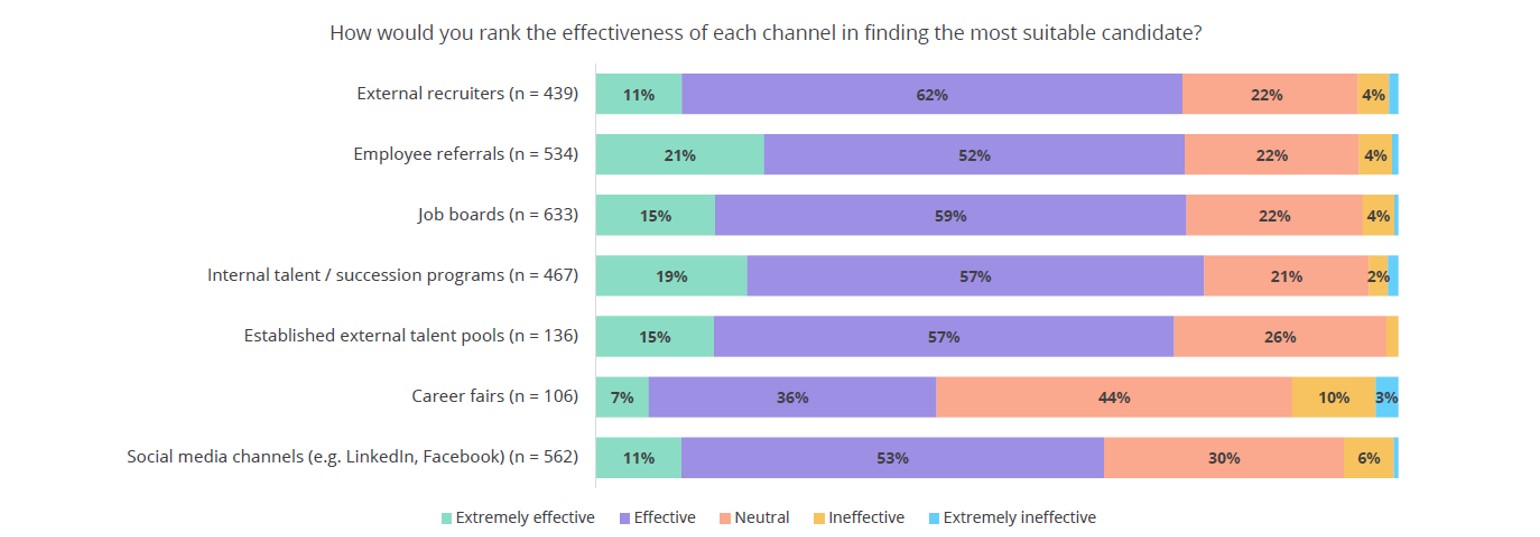8 Tips to Improve Your Recruitment Processes
Consider this: One-quarter of Australian and New Zealand workers (24% and 27% respectively) have recently considered a career change;[1] there is typically more movement in the job market at the ...

Consider this: One-quarter of Australian and New Zealand workers (24% and 27% respectively) have recently considered a career change;[1] there is typically more movement in the job market at the start of a new financial year; the job market is rebounding from a tumultuous 18 months and is looking buoyant.
All these points indicate that a power shift has occurred: employers no longer hold the power, employees do. Forget the ‘war for jobs’ – organisations should brace once again for a ‘war for talent’.
Because of this shift, there is increasing pressure on HR and talent acquisition professionals to figure out how they’re going to attract new talent into in-demand roles and, just as importantly, stop precious talent from walking out the door.
COVID-19 has redefined many business practices. In terms of recruitment, it’s very much out with the old (way of doing things), and in with the new. The new approach to hiring in a post-COVID world is informed mostly by changing attitudes to work – in particular, a general proclivity to remote-first.
In order to compete in the battle for top talent, organisations must reassess their talent acquisition strategies, ensuring they cater to employees’ needs and expectations. Below are 8 tips to maximise your chances of hiring success in FY22.
- Geographically broaden your talent pool
The first tip is to broaden your candidate pool. With many companies now operating at least partially remotely and offering employees greater opportunities for flexibility, there is potential for hiring managers to expand their talent pool to consider candidates who are geographically dispersed.
Having access to previously untapped talent pools is an exciting prospect. It means organisations aren’t limited to the candidates that are nearby but can widen their search to include people all over the state, country, or world to find candidates with the right skills and experience. What’s more, access to talent pools that are culturally and ethnically diverse is a step towards cultivating a more diverse and inclusive workforce. Find out about the five foundations of a successful D&I strategy in our blog.
- Offer flexible working
Since COVID-19, there has been an uptick in the number of people working from home. Yet, unlike during the height of the pandemic when people were mandated to work from home, the consensus now is that people want to work from home. According to ELMO’s 2021 Employee Sentiment Report in Australia and New Zealand, flexible/remote working was the number one priority for employees.
The pandemic has prompted a shift in attitudes around employee benefits and opportunities for flexible work. Flexibility should no longer be a ‘nice to have’, but a ‘must have’. If employers cannot offer flexible working opportunities, they may find it hard to attract and retain top talent – and may lose the talent war.
In addition to flexible work, employers may consider how else they can cater to the needs and expectations of employees today. A holistic approach to employee wellbeing has four key components: physical health, social health, mental health and financial health. Holistic benefits can form the foundation of an effective rewards strategy, whereby organisations can engage employees through a blend of monetary and non-monetary rewards. When implemented well, a rewards strategy can be a major acquisition and retention driver. Find out more about developing a total rewards strategy post-COVID-19 by watching our webinar here.
- Use an applicant tracking system (ATS)
To maximise recruitment efforts, hiring managers may want to utilise an applicant tracking system (ATS). An ATS is a tool that helps to manage the end-to-end management of the recruitment process: It streamlines candidate management, job listings, applications and job offers, and automates emails and interview scheduling. What’s more, with an ATS, hiring managers can create a candidate database where candidates’ skills can be screened, compared and ranked against others in relation to certain job roles.
A sophisticated and seamless recruitment experience with regular communication will give candidates a good first impression of an organisation, which can make a huge difference in securing top talent.
- Track and review source of hire (SoH)
To optimise how candidates are sourced, hiring managers can track and review the source of hire (SoH) to identify which sources – career site, job boards, social media e.g. LinkedIn, employee referrals, etc. – attract value-adding employees. As well as looking at where the high-performing employees are sourced, it also pays to look at where poor hires are sourced.
According to ELMO’s 2021 Industry Benchmark Report, which is based on a survey of 1800 HR professionals in Australia and New Zealand, the most common source channel is job boards (according to 76% respondents in 2020) – see the graph below.

Yet, the same report shows that job boards weren’t the most effective channel overall – employee referrals were, with 21% saying this source was ‘extremely effective’, compared to just 15% perceiving job boards as such. Also ranking highly was ‘internal talent / succession programs’, which 19% of respondents considered to be ‘extremely effective’. Career fairs were found to be the least effective source of hire.

Gathering these metrics can help an organisation strategise its talent acquisition approach so that the sources yielding the most successful hires are optimised.
- Improve capability for remote hiring
The pandemic was the first time many organisations engaged with remote or virtual recruitment practices – in particular, remote interviewing. Despite organisations being able to resume on-site, in-person operations (for the most part), partially remote operating will likely persist.
Therefore, enhancing remote hiring capability should be a priority for every organisation – especially if organisations are wanting to attract geographically dispersed talent (as discussed in point #1).
The criteria for effective remote hiring are as follows: A mobile-optimised career site where job listings are easily accessible; video conferencing software to conduct video interviews (e.g. Zoom); and digital documentation which can be delivered, signed and received electronically. At the core of successful remote hiring is an ATS, enabling hiring managers to track job listings, review candidates and automate tasks (discussed in #3).
If an organisation has not updated its recruitment processes to suit a remote-first context, it risks looking amateurish and may put off top talent.
- Harness AI and machine learning
AI and machine learning within HR has been gaining momentum over recent years. Its primary benefit is to provide efficiency gains; it allowed us to do the same things we always did, but faster and more cost-effectively.
Recruitment and talent acquisition is an area where AI and machine learning has really proven their worth. It enables faster hiring by assessing skills match for roles, predicting the likelihood of future success, and estimating the expected time to fill any given role. Examples of tasks AI can automate include:
- Analysing recruitment trends and patterns
- Scanning resumes, job descriptions and offer letters
- Matching candidates to jobs
- Screening large volumes of candidates
Automating such tasks – many of which can be cumbersome, time-consuming and prone to human error and bias – can be a game changer for recruitment effectiveness.
- Gather feedback from candidates and new hires
In this fast-evolving world, organisations should be continually looking for ways to improve business processes. As the recruitment process is typically the first interaction a person will have with an organisation, it can make or break a candidate-employer relationship, so getting it right is important.
Asking for feedback from candidates who have experienced your recruitment process first-hand can help to identify any areas for improvement or cause for concern. Using employee listening platforms such as surveys is an easy way to gain a snapshot on how the candidate and new hire experience is received.
- Hire for soft skills
In recent years, there has been an emphasis on the importance of hiring for ‘soft’ skills (also referred to as ‘essential’ skills or ‘human’ skills). COVID-19 has accelerated this trend.
Of course, hard ‘technical’ skills are important, but hiring managers may give weight to soft, interpersonal skills – things like empathy, collaboration, resilience, problem-solving, etc. After all, dealing with change has become an occupational hazard for workers in this post-pandemic world, so these qualities are attractive, especially for leadership roles. The good news is that soft skills can be developed through training opportunities and short courses. Find out more about the soft skills vs. hard skills debate in our blog here.
Conclusion
The recruitment landscape has evolved dramatically since pre-pandemic times, and organisations must continually review processes to ensure they address the expectations of employees today. This is made easier with ELMO Recruitment and applicant tracking system (ATS) – a highly configurable system that helps streamline the hiring process from job requisition approval through to offer acceptance. It enables organisations to build candidate sourcing capability and helps you refine recruitment workflows, screening questions and interview processes – all while promoting your value proposition to attract the best talent. ELMO’s Recruitment solution fully integrates with the entire ELMO cloud HR & payroll suite.
ELMO Software offers people, process and pay solutions in an all-in-one cloud-based platform. This includes recruitment, learning, performance management, payroll, expenses, and more. ELMO has helped thousands of organisations across Australia, New Zealand and the UK better manage, engage and inspire their people. For further information, contact us.
[1] ELMO Employee Sentiment Report, Australia & New Zealand, January-March 2021
 HR Core
HR Core 









